The SSD Relapse: Understanding and Choosing the Best SSD
by Anand Lal Shimpi on August 30, 2009 12:00 AM EST- Posted in
- Storage
What's Wrong with Samsung?
The largest SSD maker in the world is Samsung. Samsung makes the drives offered by Apple in its entire MacBook/MacBook Pro lineup. Samsung makes the drives you get if you order a Lenovo X300. In fact, if you're buying any major OEM system with an SSD in it, Samsung makes that drive.
It's just too bad that those drives aren’t very good.
This is the 4KB random write performance of Samsung's latest SSD, based on the RBB controller:
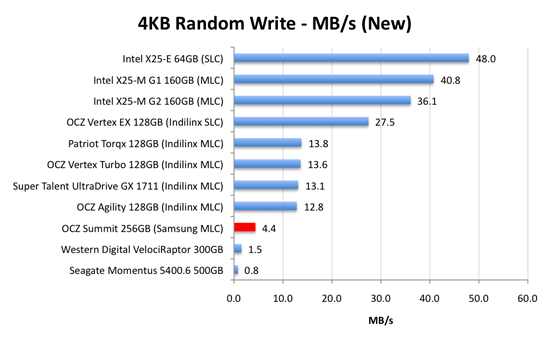
4.4MB/s. That's 3x the speed of a VelociRaptor, but 1/3 the speed of a cheaper Indilinx drive.
Speedy, but not earth shattering. Now let's look at performance once every LBA has been written to. This is the worst case scenario performance we've been testing for the past year:
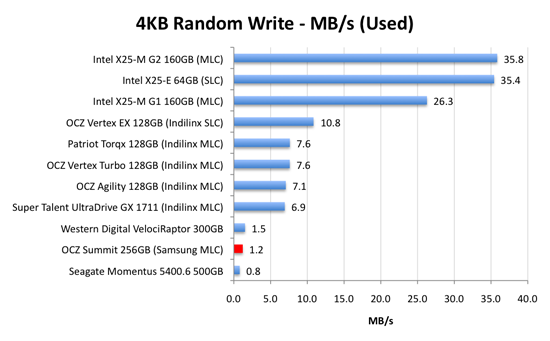
...and now we're down to mechanical hard drive speeds
Holycrapwtfbbq? Terrible.
Now to be fair to Samsung, this isn’t JMicron-terrible performance. It’s just not worth the money performance.
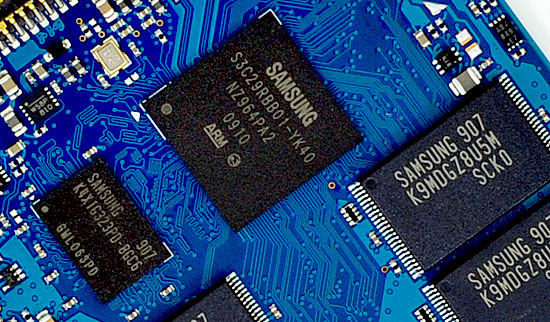
The Samsung RBB based SSDs are rebranded by at least two manufacturers: OCZ and Corsair.
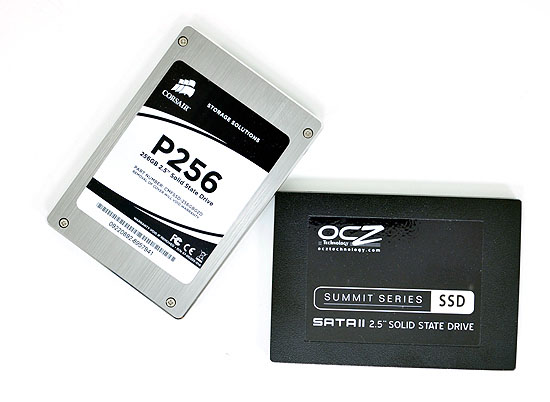
The OCZ Summit and the Corsair P256 both use the Samsung RBB platform.

The Corsair and OCZ Samsung RBB drives.
The drive most OEMs are now shipping is an even older, lower performing Samsung SSD based on an older controller.
I talked to some of the vendors who ship Samsung RBB based SSDs and got some sales data. They simply can’t give these drives away. The Indilinx based drives outsell those based on the Samsung RBB controller by over 40:1. If end users are smart enough to choose Indilinx and Intel, why aren't companies like Apple and Lenovo?
Don't ever opt for the SSD upgrade from any of these OEMs if you've got the option of buying your own Indilinx or Intel drive and swapping it in there. If you don't know how, post in our forums; someone will help you out.
Samsung realized it had an issue with its used-state performance and was actually the first to introduce background garbage collection; official TRIM support will be coming later. Great right? Not exactly.
There’s currently no way for an end user to flash the firmware on any of these Samsung drives. To make matters worse, there’s no way for companies like OCZ or Corsair to upgrade the firmware on these drives either. If you want a new firmware on the drive, it has to go back to Samsung. I can’t even begin to point out how ridiculous this is.
If you’re lucky enough to get one of the Samsung drives with background garbage collection, then the performance drop I talked about above doesn’t really matter. How can you tell? Open up Device Manager, go to your SSD properties, then details, then select Hardware Ids from the dropdown. Your firmware version will be listed at the end of your hardware id string:
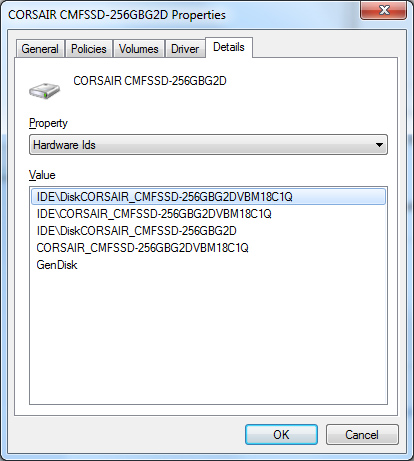
Version 1801Q doesn’t support BGC. Version 18C1Q (or later) does.
How can you ensure you get a model with the right firmware revision? Pick a religion and start praying, because that’s the best you can do.
Now the good news. When brand new, the Samsung drives actually boast competitive sequential write, sequential read and random write speeds.
These drives are also highly compatible and very well tested. For all of the major OEMs to use them they have to be. It’s their random write performance that’s most disappointing. TRIM support is coming later this year and it will help keep the drives performing fresh, but even then they are still slower than the Indilinx alternatives.
There’s no wiper tool and there’s currently no method to deploy end-user flashable firmware updates. Even with TRIM coming down the road, the Samsung drives just don’t make sense.










295 Comments
View All Comments
minime - Tuesday, September 1, 2009 - link
Thanks for that, but still, this is not quite a real business test, right?Live - Monday, August 31, 2009 - link
Great article! Again I might add.Just a quick question:
In the article it says all Indilinx drives are basically the same. But there are 2 controllers:
Indilinx IDX110M00-FC
Indilinx IDX110M00-LC
What's the difference?
yacoub - Monday, August 31, 2009 - link
If Idle Garbage Collection cannot be turned off, how can it be called "[Another] option that Indilinx provides its users"? If it's not optional, it's not an option. :(Anand Lal Shimpi - Monday, August 31, 2009 - link
Well it's sort of optional since you had to upgrade to the idle GC firmware to enable it. That firmware has since been pulled and I've informed at least one of the companies involved of the dangers associated with it. We'll see what happens...Take care,
Anand
helloAnand - Monday, August 31, 2009 - link
Anand,The best way to test compiler performance is compiling the compiler itself ;). GCC has an enormous test suite (I/O bound) to boot. Building it on windows is complicated, so you can try compiling the latest version on the mac.
Anand Lal Shimpi - Monday, August 31, 2009 - link
Hmm I've never played with the gcc test suite, got any pointers you can email me? :)Take care,
Anand
UNHchabo - Tuesday, September 1, 2009 - link
Compiling almost anything on Visual Studio also tends to be IO-bound, so you could try that as well.CMGuy - Wednesday, September 2, 2009 - link
We've got a few big java apps at work and the compile times are heavily I/O bound. Like it takes 30 minutes to build on a 15 disk SAN array (The cpu usage barely gets above 30%). Got a 160Gig G2 on order, very much looking forward to benchmarking the build on it!CMGuy - Sunday, October 11, 2009 - link
Finally got an X25-m G2 to benchmark our builds on. What was previously a 30 minute build on a 15 disk SAN array in a server has become a 6.5 minute build on my laptop.The real plus has come when running multiple builds simultaneously. Previously 2 builds running together would take around 50 minutes to complete (not great for Continuous Integration). With the intel SSD - 10 minutes and the bottleneck is now the CPU. I see more cores and hyperthreading in my future...
Ipatinga - Monday, August 31, 2009 - link
Another great article about SSD, Anand. Big as always, but this is not just a SSD review or roundup. It´s a SSD class.Here are my points about some stuff:
1 - Correct me if I´m wrong, but as far as capacity goes, this is what I know:
- Manufacturers says their drive has 80GB, because it actually has 80GB. GB comes from GIGA, wich is a decimal unit (base 10).
- Microsoft is dumb, so Windows follows it, and while the OS says your 80GB drive has 74,5GB, it should say 80GB (GIGA). When windows says 74,5, it should use Gi (Gibi), wich is a binary unit).
- To sum up, with a 80GB drive, Windows should say it has 80GB or 74,5GiB.
- A SSD from Intel has more space than it´s advertised 80GB (or 74,5GiB), and that´s to use as a spare area. That´s it. Intel is smart for using this (since the spare area is, well, big and does a good job for wear and performance over sometime).
2 - I wonder why Intel is holding back on the 320GB X25-M... just she knows... it must be something dark behind it...
Maybe, just maybe, like in a dream, Intel could be working on a 320GB X25-M that comes with a second controller (like a mirror of the one side pcb it has now). This would be awesome... like the best RAID 0 from two 160GB, in one X25-M.
3 - Indilinx seems to be doing a good job... even without TRIM support at it´s best, the garbage cleaning system is another good tool to add to a SSD. Maybe with TRIM around, the garbage cleaning will become more like a "SSD defrag".
4 - About the firmware procedure in Indilinx SSD goes, as far as I know, some manufacturers use the no-jumper scheme to make easier the user´s life, others offer the jumper scheme (like G.Skill on it´s Falcon SSD) to get better security: if the user is using the jumper and the firmware update goes bad, the user can keep flashing the firmware without any problem. Without the jumper scheme, you better get lucky if things don´t go well on the first try. Nevertheless, G.Skill could put the SSD pins closer to the edge... to put a jumper in those pins today is a pain in the @$$.
5 - I must ask you Anand, did you get any huge variations on the SSD benchmarks? Even with a dirty drive, the G.Skill Falcon (I tested) sometimes perform better than when new (or after wiper). The Benchmarks are Vantage, CrystalMark, HD Tach, HD Tune.... very weird. Also, when in new state, my Vantage scores are all around in all 8 tests... sometimes it´s 0, sometimes it´s 50, sometimes it´s 100, sometimes it´s 150 (all thousand)... very weird indeed.
6 - The SSD race today is very interesting. Good bye Seagate and WD... kings of HD... Welcome Intel, Super Talent, G.Skill, Corsair, Patriot, bla bla bla. OCZ is also going hard on SSD... and I like to see that. Very big line of SSD models for you to choose and they are doind a good job with Indilinx.
7 - Samsung? Should be on the edge of SSD, but manage to loose the race on the end user side. No firmware update system? You gotta be kidding, right? Thank good for Indilinx (and Intel, but there is not TRIM for G1... another mistake).
8 - And yes... SSD rocks (huge performance benefit on a notebook)... even though I had just one weekend with them. Forget about burst speed... SSD crushes hard drives where it matters, specially sequencial read/write and low latency.
- Let me finish here... this comment is freaking big.